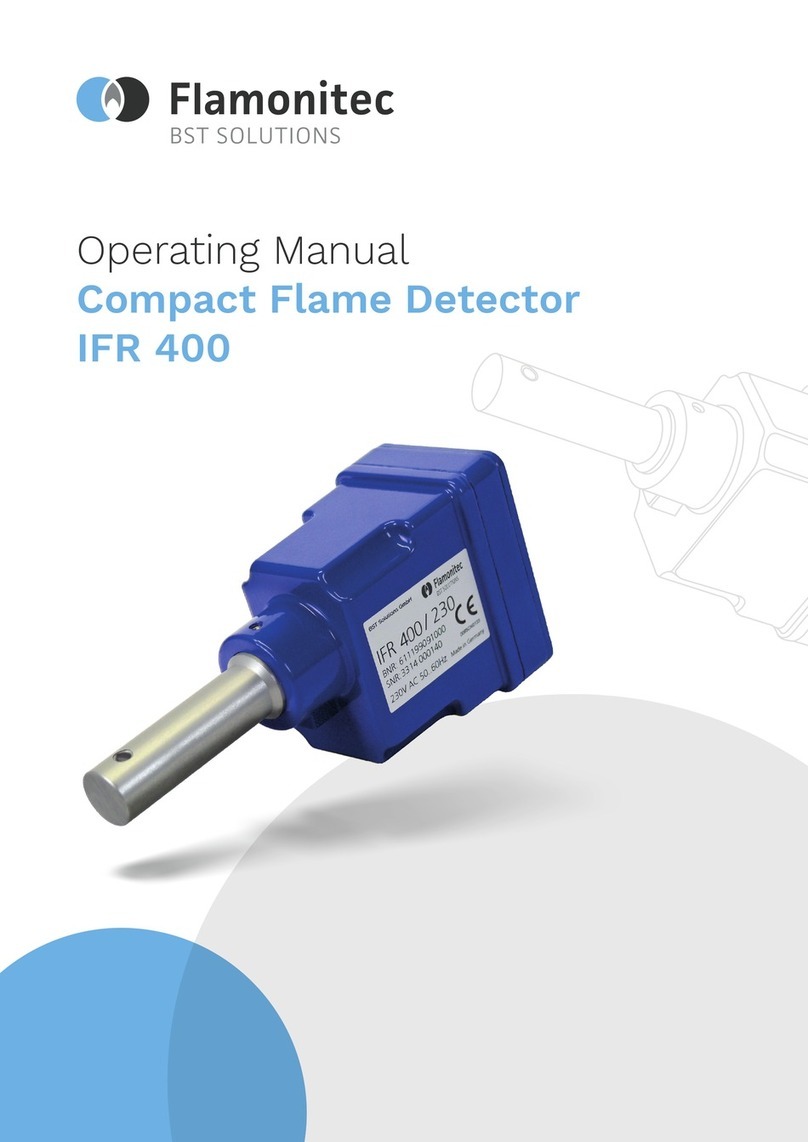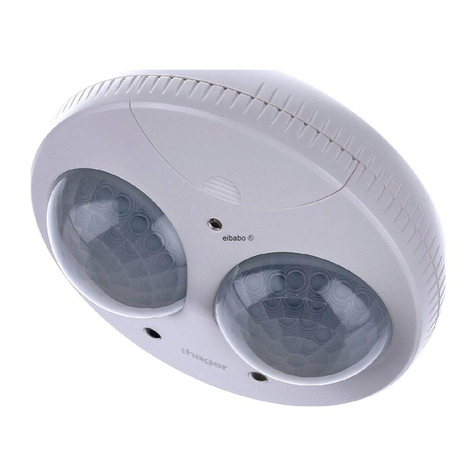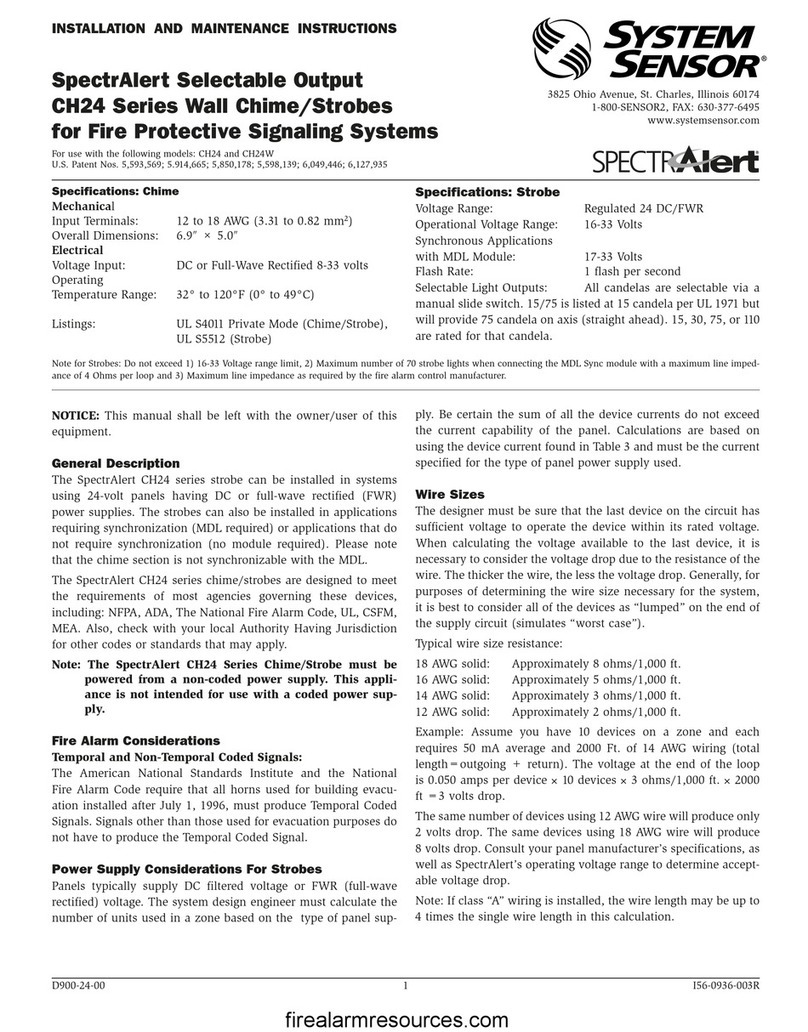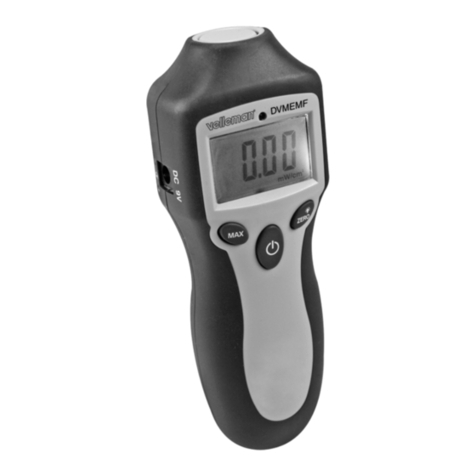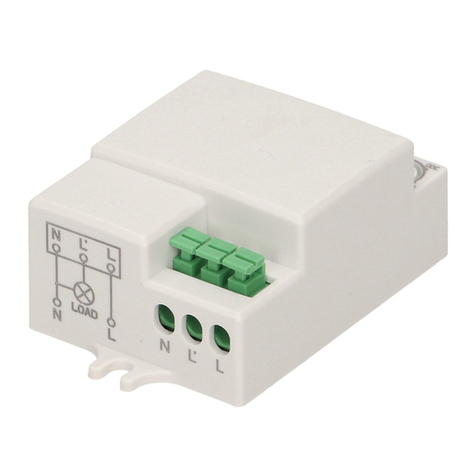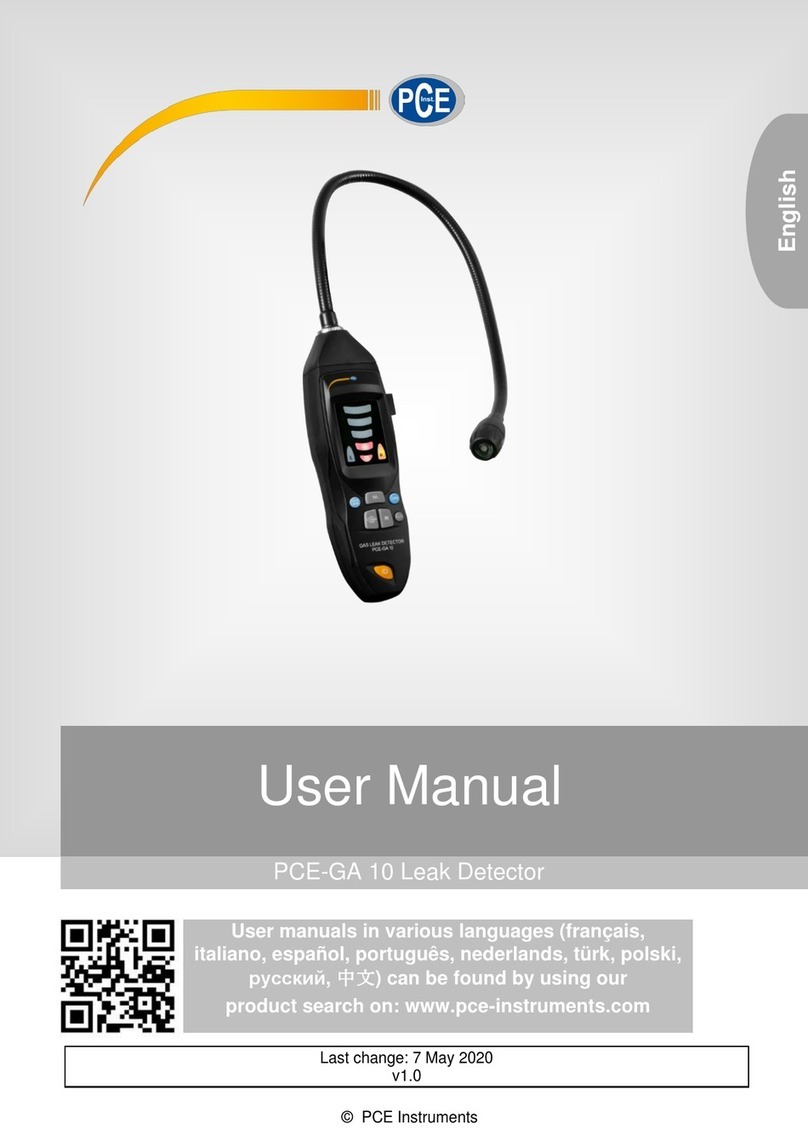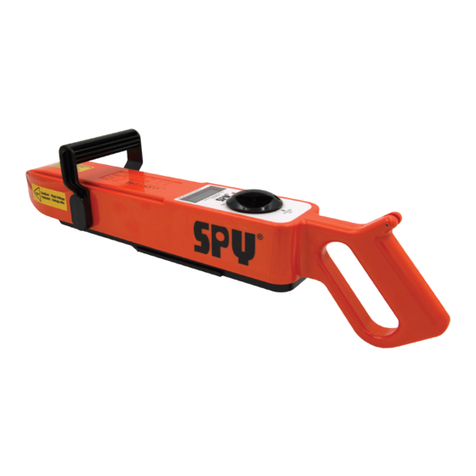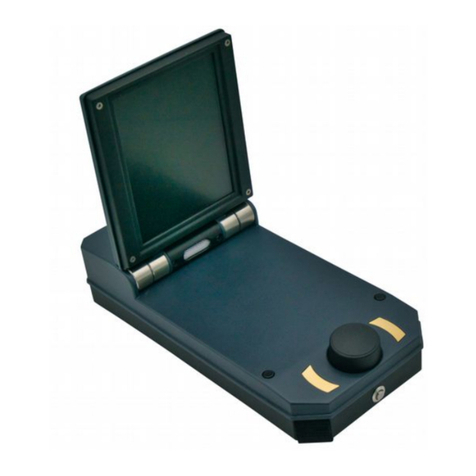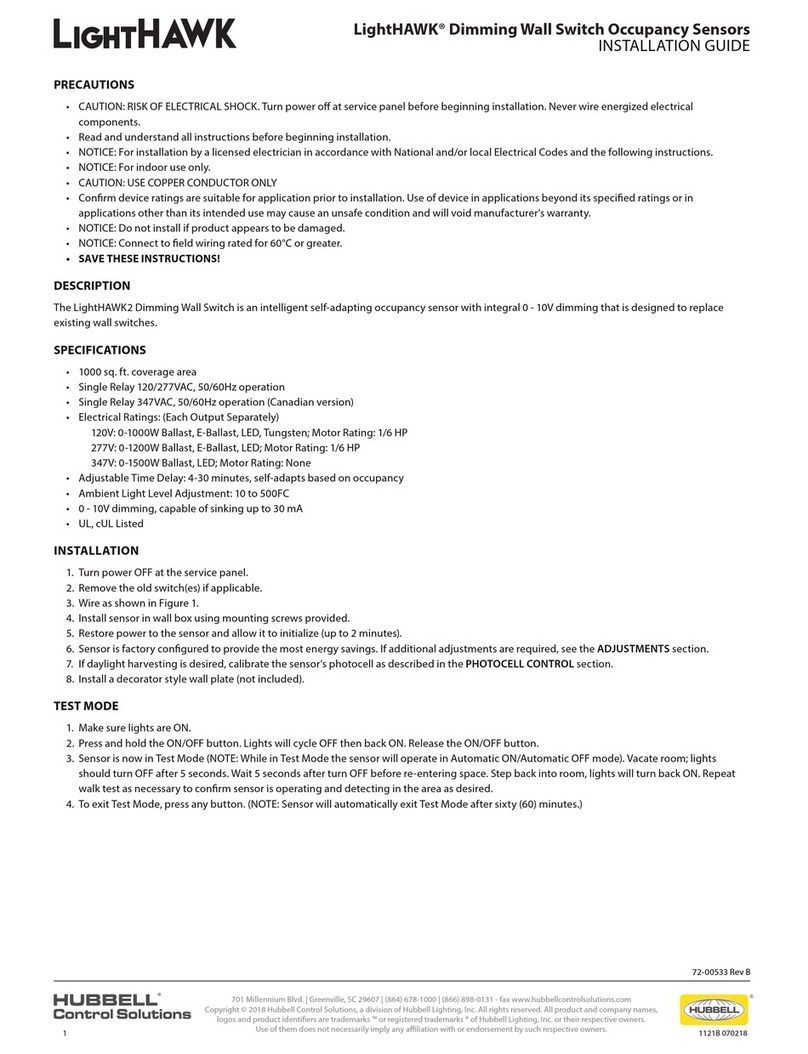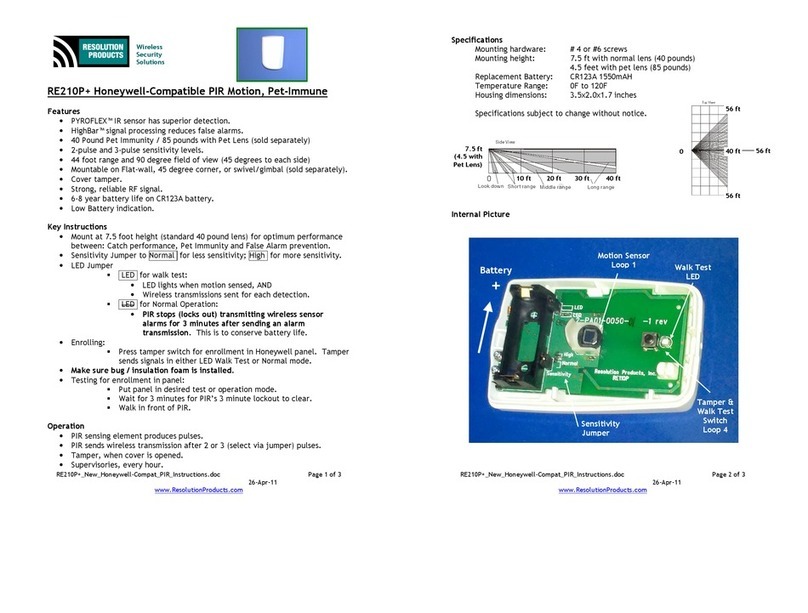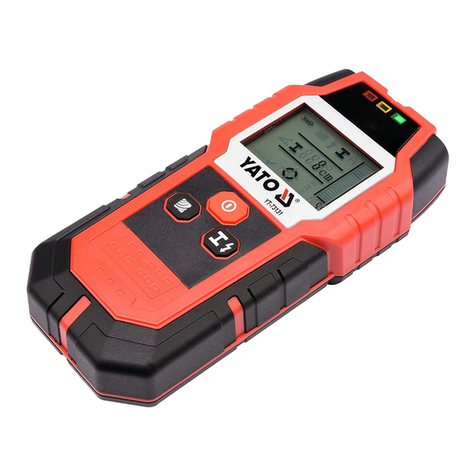AEMC instruments 275HVD User manual

NON-CONTACT,
HIGH VOLTAGE DETECTOR
DETECTOR DE ALTA
TENSIÓN SIN CONTACTO
275HVD
TEST
OFF
240V
2kV
6kV
11kV
22kV
33kV
132kV
275kV
ENGLISH User Manual
ESPAÑOL Manual de Instrucciones

Owner’s Record
The serial number for the Model 275HVD is located around the collar of
the instrument. Please record this number and purchase date for your
records.
NON-CONTACT HIGH VOLTAGE DETECTOR MODEL 275HVD
CATALOG #: 2131.12
SERIAL #: _______________________________________________
PURCHASE DATE: ________________________________________
DISTRIBUTOR: ___________________________________________

Non-Contact, High Voltage Detector 275HVD
1
Table of Contents
1. INTRODUCTIONINTRODUCTION............................................................................... 2
1.1 International Electrical Symbols................................................3
1.2 Receiving Your Shipment..........................................................3
1.3 Ordering Information.................................................................3
2. PRODUCT FEATURES ...................................................................... 4
2.1 Description................................................................................4
2.2 Typical Uses .............................................................................5
2.3 275HVD Features.....................................................................6
3. SPECIFICATIONS............................................................................. 7
3.1 Electrical ...................................................................................7
3.2 Mechanical................................................................................7
3.3 Environmental...........................................................................7
3.4 Detection Levels .......................................................................8
4. OPERATION .................................................................................. 10
4.1 Preparation for Use.................................................................10
4.2 Limitations on the Model 275HVD ..........................................10
4.3 Testing the 275HVD Before Operating ...................................11
4.4 High Voltage Testing...............................................................11
4.5 Low Voltage Testing................................................................12
4.6 Faults (Open) in Cables..........................................................13
4.7 Changing the Batteries ...........................................................13
Repair and Calibration...........................................................................14
Technical and Sales Assistance ............................................................14
Limited Warranty ...................................................................................15
Warranty Repairs...................................................................................15
ENGLISH ................................................................................................... 1
ESPAÑOL................................................................................................. 17

2
Non-Contact, High Voltage Detector 275HVD
CHAPTER 1
INTRODUCTION
Warning
The Model 275HVD Non-Contact High Voltage Detector has been
designed with safety in mind. However, no design can completely pro-
tect against incorrect use. The 275HVD should be used by trained and
qualied personnel only. The 275HVD can only be used with an insulated
rod or “Hot Stick” rated at the appropriate working voltage. The 275HVD
Non-Contact High Voltage Detector is never to be put into direct contact
with a live conductor.
If caution or poor safety practices are not adhered to, electrical cir-
cuits can be dangerous and lethal.
This instrument should only be used by authorized and properly
trained personnel who fully understand the High Voltage testing
procedures.
Personnel working with high voltages should be trained regularly.
• Read the user manual carefully and completely before using the
tester. Fully understand the instructions before using this product.
• Follow the instructions for every test.
• Take all the necessary safety precautions. Do not exceed the limits
of this instrument.
• The 275HVD Non-Contact High Voltage Detector must never be in
physical contact with any conductor. This is a proximity detector, not
a detector which works by contact.
• Tests must only be carried out with the 275HVD attached to an
approved insulated berglass rod or Hot Stick.
• Always use an authorized berglass (or equivalent) rod or Hot Stick
appropriately rated for the voltage with which you are working.
• Always check that the 275HVD Non-Contact High Voltage Detector
is working before and after the test.
• Verify the Range Switch setting before measuring. Make sure it is on
the correct setting for your application.
• Do not touch any exposed wiring, connections, or other “live” parts of
an electrical circuit.

Non-Contact, High Voltage Detector 275HVD
3
1.1 International Electrical Symbols
This symbol on the instrument indicates a WARNING and that
the operator must refer to the user manual for instructions before
operating the instrument. In this manual, the symbol preceding
instructions indicates that if the instructions are not followed, bodily
injury, installation/sample and product damage may result.
Risk of electric shock. The voltage at the parts marked with this
symbol may be dangerous.
1.2 Receiving Your Shipment
Upon receiving your shipment, make sure that the contents are consistent
with the packing list. Notify your distributor of any missing items. If the
equipment appears to be damaged, le a claim immediately with the car-
rier and notify your distributor at once, giving a detailed description of any
damage. Save the damaged packing container to substantiate your claim.
Do not use an instrument that appears to be damaged.
1.3 Ordering Information
Non-Contact High Voltage Detector
Model 275HVD....................................................................Cat. #2131.12
Includes three 1.5V “C” cell batteries, shotgun adapter, carrying case, and user
manual.

4
Non-Contact, High Voltage Detector 275HVD
CHAPTER 2
PRODUCT FEATURES
2.1 Description
The Non-Contact High Voltage Detector Model 275HVD is a high voltage
detector by proximity. It is not designed to enter into contact with conduc-
tors.
The 275HVD should never touch conductors and must be used with an
insulated berglass rod or Hot Stick appropriately rated for the voltage
being tested.
The Non-Contact High Voltage Detector Model 275HVD is not a “measur-
ing instrument” per say, rather it is a product designed to warn the user of
the presence of voltage in a particular work site.
The 275HVD uses an internal sensor designed to detect the radiated elec-
trical eld (V/m) present in energized conductors. The radiated electrical
eld increases with the line voltage but decreases with distance and/or
shielding.
The 275HVD has eight voltage range settings. These correspond to inter-
nal eld sensitivity settings: the lower the voltage setting; the higher the
sensitivity to detect the electrical eld; and, the greater the detection dis-
tance. It also has an “auto-test” setting to check functionality (see § 4.3).
The 275HVD is battery powered and contains three standard 1.5V “C”
cells in the shaft below the sensing head.
When an electrical eld is detected, a sound annunciator (high-pitch, high
-powered buzzer) and visual indicators (bright LEDs) are triggered ON,
warning the user.
The body is made out of industrial grade UL rated polyamide (Type 66
Nylon). The shotgun adapter at the shaft end is designed to t into most
Hot Stick adaptors.

Non-Contact, High Voltage Detector 275HVD
5
2.2 Typical Uses (always use a Hot Stick)
• Identify and check live cables
• Check and detect live high voltage cables
• Find fault in exible cables
• Check grounding equipment
• Service neon lighting
• Trace live wires
• Check high frequency radiation
• Detect residual or induced voltages
IMPORTANT WARNING
The 275HVD detects radiated electrical elds. To accomplish
this, an energized cable or sample must radiate an electrical
eld. Shielded cables or shielded samples do not radiate, or
radiate very small electrical elds. Also, cables with concen-
tric neutrals will have a smaller/lower radiated eld than plain
insulated cables.
The 275HVD may not detect, as expected, an electrical eld
on shielded cables (buried cables are often shielded) or
shielded samples and the 275HVD has lower sensitivity on
cables with concentric neutrals.
It is not recommended to use the 275HVD on shielded
cables or shielded samples. Use extreme care on cables
with concentric neutrals (use a low setting).

6
Non-Contact, High Voltage Detector 275HVD
2.3 275HVD Features
1. Warning Light - Bright, low current Red LEDs triggered on voltage
detection
2. Warning Buzzer - High noise level buzzer triggered on voltage
detection
3. Rotary Selector with the following settings:
• OFF - Turn the pick-up sensor off
• TEST -
Veries that the circuitry
is working
• 240V - 2kV - 6kV - 11kV - 22kV - 33kV - 132kV - 275kV
4. Battery Holder
5. Shotgun adapter end tting for Hot Stick connection

Non-Contact, High Voltage Detector 275HVD
7
CHAPTER 3
SPECIFICATIONS
3.1 Electrical
Ranges: 240V, 2kV, 6kV, 11kV, 22kV, 33kV, 132kV, 275kV
Detection Frequency: 40 to 70Hz
Power Supply: Three 1.5V “C” cell batteries
Power Consumption: 40mA
Signal Lamp: 47 lux @ 20cm
Sound Volume: 75 db @ 1m from detector
3.2 Mechanical
Case Height: 9" (229mm)
Case Width: 3.78" (96mm)
Weight: 1.30 lbs (0.59kg) batteries included
Shock Test: IEC 68-2-29
Vibration Test: EN 61010, clause 8.3
Drop Test: EN 61010, clause 8.4
Impact Test: EN 61010, clause 8.2
3.3 Environmental
Operating Temperature: 5° to 130°F (-15° to 55°C)
Storage Temperature: -4° to 150°F (-20° to 65°C)
Humidity: 0 to 93% RH @ 104°F (40°C)
Cold Temperature: IEC 68-2-1
Dry Heat: IEC 68-2-2
Damp Heat: IEC 68-2-3

8
Non-Contact, High Voltage Detector 275HVD
3.4 Detection Levels
The 275HVD is used by moving it closer to the live conductor until the
buzzer and light warnings are triggered. It is designed to detect at a lower
voltage than the range setting.
The following data is considered as typical response for the 275HVD. Vari-
ations may occur from unit to unit. As a general rule, in a “clean” environ-
ment, the 275HVD will trigger @ 45 to 65% of the voltage range at 4"/10cm,
and detected the selected voltage setting at 8 to 12" (20 to 30cm).
The following data provides indicative distances at which the 275HVD will
detect a given voltage. Note that these tests were conducted in ideal test
conditions (unshielded single conductor, lab environment, sensor head
perpendicular to conductor) and are not fully representative of the work
site, which may have other voltages present (and which may inuence the
overall results).
The distances should only be taken as indicative and not as electrical
specications. Care should be taken when in presence of other conductors
which may also be detected by the 275HVD (see § 4.2). Measurements
are based upon a 90° angle (sensor head perpendicular to conductor).
Range Setting Distance Voltage Detection
240V 4" – 10cm 75V – 90V
2kV 4" – 10cm 1.3kV
6kV 4" – 10cm 3.6kV
11kV 4" – 10cm 7.5kV
22kV 4" – 10cm 11kV
33kV 4" – 10cm 19.5kV
132kV 4" – 10cm Not Rated
275kV 4" – 10cm Not Rated
Range Setting Voltage Distance
240V 240V 10.5" - 27cm
2kV 2kV 10.5" - 27cm
6kV 6kV 11.5" - 29cm
11kV 11kV 10.5" - 27cm
22kV 22kV 12.2" - 31cm
33kV 33kV 11.0" - 28cm
132kV 132kV 10.0" - 25cm
275kV 275kV 10.0" - 25cm

Non-Contact, High Voltage Detector 275HVD
9
The following information provides typical detection distances when using
a lower setting than the line voltage.
Note that the distances may vary with each unit and will be affected based
on the actual environment. The values displayed were conducted in an
ideal lab environment and cannot represent each eld environment.
SETTING VOLTAGE DISTANCE
240VAC 500VAC 12" - 32cm
240VAC 1kVAC 18" - 48cm
240VAC 2kVAC 29" - 75cm
240VAC 6kVAC 48" - 124cm
240VAC 11kVAC 57" - 146cm
240VAC 22kVAC 89" - 226cm
SETTING VOLTAGE DISTANCE
2kVAC 6kVAC 16" - 40cm
2kVAC 11kVAC 20" - 52cm
2kVAC 22kVAC 24" - 60cm
2kVAC 33kVAC 36" - 92cm
SETTING VOLTAGE DISTANCE
6kVAC 11kVAC 24" - 61cm
6kVAC 22kVAC 29" - 75cm
6kVAC 33kVAC 41" - 105cm
SETTING VOLTAGE DISTANCE
11kVAC 22kVAC 13" - 35cm
11kVAC 33kVAC 16" - 42cm
SETTING VOLTAGE DISTANCE
22kVAC 33kVAC 14" - 36cm

10
Non-Contact, High Voltage Detector 275HVD
CHAPTER 4
OPERATION
4.1 Preparation for Use
The Non-Contact High Voltage Detector should be inspected for any visible
signs of damage before using, battery condition and the checks described
below should be performed to ensure that it is operating correctly.
When you rst receive it, if there is any sign of damage or if the instrument
does not operate correctly, return it to the distributor from which it was
purchased.
4.2 Limitations on the Model 275HVD
See Warning on Page 5
• Testing voltages on cable composed of multiple phases may be a prob-
lem. In particular, multiple phase cables twisted together may have
their electrical elds canceling each other out (vector sum), and a much
lower detectable eld signal may result. This may lead to non-detection
if the range setting is too high. Try a lower range setting if this situa-
tion occurs. Keep in mind that the actual line voltage may be much
higher!
• Problems can arise when the 3-phase circuit of a 275/133/11kV trans-
formers are tested. The electric eld of the HV and MV bus bars can
trigger the detector when it is about one meter (approx 3 ft) above the
ground. Users must be aware that this is common with most of the
electric eld voltage detectors. The 275HVD can pick up adjacent cir-
cuit electrical elds to the one being tested and may indicate the wrong
information to the user.
• Electrical Field sensitivity is reduced when the 275HVD is used close
to grounding points.
• The Model 275HVD will work on cables with a concentric neutral.
• The Model 275HVD will not work on shielded cables.

Non-Contact, High Voltage Detector 275HVD
11
4.3 Testing the 275HVD Before Operating
Switch the sensitivity to “TEST”. The warning buzzer should emit continu-
ous audible tone and the warning light LEDs should light up. This indicates
that the sensor is operational and the battery functional.
Perform the following steps to ensure that the 275HVD detects volt-
age on a known live conductor.
• Select the 240VAC range and place the sensing head near a known
live (low voltage) conductor (if not available, rub the sensor with
a cloth or against a clothing item to generate a DC static charge
which will trigger the sensor circuit detection).
• The warning light and warning beeper should go ON as if a live
conductor were being tested.
NOTE: Positioning the sensing dome near a computer screen or a TV
screen (not liquid crystal display type) should also trigger the tester while
on the 240V selection.
4.4 High Voltage Testing
See Warning on Page 5
The 275HVD Non-Contact High Voltage Detector works by proximity. It
is not designed to be in physical contact with live conductors. Its sensor
detects the radiated eld which surrounds live conductors.
Do not touch live conductors with the 275HVD
Non-Contact High Voltage Detector.
Radiated eld strength increases with voltage and decreases quickly with
distance and/or ground shielding. The radiated eld from a cable where
conductors supplying three-phase power are close together, tends to
cancel out (See § 4.2). The rotary switch (attenuator) is used to identify
and differentiate various HV live cables.
The tester must only be used with an appropriate insu-
lated rod or Hot Stick when measuring High Voltage.

12
Non-Contact, High Voltage Detector 275HVD
After checking the 275HVD and ensuring its good operation, select the
test range. It is recommended to start with a lower setting than the actual
working voltage, and then to try again with higher settings. The user may
also consider using lower settings to check for lower voltages on a con-
ductor.
With the 275HVD at the end of a hot stick, move towards the live conduc-
tor until its warnings are triggered.
TEST
OFF
240V
2kV
6kV
11kV
22kV
33kV
132kV
275kV
Hot Stick
4.5 Low Voltage Testing
See Warning on Page 5
The 275HVD Non-Contact High Voltage Detector works by proximity. The
275HVD is not designed to be in physical contact with live conductors. Its
sensor detects the radiated eld that surrounds live conductors.
Do not touch live conductors with the 275HVD
Non-Contact High Voltage Detector.
Radiated eld strength increases with voltage and decreases quickly with
distance and/or ground shielding. The radiated eld from a cable where
conductors supplying three-phase power are close together, tends to
cancel out (See § 4.2). Detecting distance of a 250VAC single live wire
is about 4" (10cm). When grouped with neutral and ground wires, as in a
exible cable, the distance is reduced to 2" (5cm) or less.

Non-Contact, High Voltage Detector 275HVD
13
4.6 Faults (Open) in Cables
See Warning on Page 5
Faults in certain exible cables can be detected with the 275HVD. If the
cable is still energized, set the 275HVD sensitivity so that it triggers, then
move the 275HVD along the cable until a change in condition is obtained.
An audible tone and LED should be on when the sensor is on the supply
side of the open and will turn off when on the other side.
TEST
OFF
240V
2kV
6kV
11kV
22kV
33kV
132kV
275kV
Hot Stick
4.7 Changing the Batteries
Batteries should be checked with a multimeter and replaced periodically.
The 275HVD Non-Contact High Voltage Detector uses 3 x 1.5V “C” cell
batteries.
Open the battery compartment (turn the shaft counter-clockwise) to
remove the batteries. Ensure that polarity is respected when installing new
batteries.

14
Non-Contact, High Voltage Detector 275HVD
Repair and Calibration
To ensure that your instrument meets factory specications, we recommend
that it be scheduled back to our factory Service Center at one-year intervals
for recalibration, or as required by other standards or internal procedures.
For instrument repair and calibration:
You must contact our Service Center for a Customer Service Authorization
Number (CSA#). This will ensure that when your instrument arrives, it will be
tracked and processed promptly. Please write the CSA# on the outside of the
shipping container. If the instrument is returned for calibration, we need to
know if you want a standard calibration, or a calibration traceable to N.I.S.T.
(Includes calibration certicate plus recorded calibration data).
Ship To: Chauvin Arnoux®, Inc. d.b.a. AEMC®Instruments
15 Faraday Drive
Dover, NH 03820 USA
Phone: (800) 945-2362 (Ext. 360)
(603) 749-6434 (Ext. 360)
Fax: (603) 742-2346 or (603) 749-6309
E-mail: [email protected]
(Or contact your authorized distributor)
Costs for repair, standard calibration, and calibration traceable to N.I.S.T. are
available.
NOTE: You must obtain a CSA# before returning any instrument.
Technical and Sales Assistance
If you are experiencing any technical problems, or require any assistance with
the proper operation or application of your instrument, please call, mail, fax or
e-mail our technical support team:
Chauvin Arnoux®, Inc. d.b.a. AEMC®Instruments
200 Foxborough Boulevard
Foxborough, MA 02035 USA
Phone: (800) 343-1391
(508) 698-2115
Fax: (508) 698-2118
E-mail: [email protected]
www.aemc.com
NOTE: Do not ship Instruments to our Foxborough, MA address.

Non-Contact, High Voltage Detector 275HVD
15
Limited Warranty
The Model 275HVD Non-Contact High Voltage Detector is warranted to the
owner for a period of three (3) years from the date of original purchase against
defects in manufacture. This limited warranty is given by AEMC®Instruments,
not by the distributor from whom it was purchased. This warranty is void if the
unit has been tampered with, abused or if the defect is related to service not
performed by AEMC®Instruments.
For full and detailed warranty coverage, please read the Warranty
Coverage Information, which is attached to the Warranty Registration
Card (if enclosed) or is available at www.aemc.com. Please keep the
Warranty Coverage Information with your records.
What AEMC®Instruments will do:
If a malfunction occurs within the three-year period, you may return the
instrument to us for repair, provided we have your warranty registration
information on le or a proof of purchase. AEMC®Instruments will, at its option,
repair or replace the faulty material.
REGISTER ONLINE AT:
www.aemc.com
Warranty Repairs
What you must do to return an Instrument for Warranty Repair:
First, request a Customer Service Authorization Number (CSA#) by phone
or by fax from our Service Department (see address below), then return the
instrument along with the signed CSA Form. Please write the CSA# on the
outside of the shipping container. Return the instrument, postage or shipment
pre-paid to:
Ship To: Chauvin Arnoux®, Inc. d.b.a. AEMC®Instruments
15 Faraday Drive • Dover, NH 03820 USA
Phone: (800) 945-2362 (Ext. 360)
(603) 749-6434 (Ext. 360)
Fax: (603) 742-2346 or (603) 749-6309
E-mail: [email protected]
Caution: To protect yourself against in-transit loss, we recommend you insure
your returned material.
NOTE: You must obtain a CSA# before returning any instrument.

16
Non-Contact, High Voltage Detector 275HVD
Notes:

Detector de Alta Tensión Sin Contacto Modelo 275HVD
17
Tabla de Contenidos
ENGLISH ................................................................................................... 1
ESPAÑOL................................................................................................. 17
1. INTRODUCCIÓN............................................................................. 18
1.1 Símbolos Eléctricos Internacionales.......................................19
1.2 Recepción de su embarque....................................................19
1.3 Información para poner una orden .........................................19
2. CARACTERÍSTICAS DEL PRODUCTO .............................................. 20
2.1 Descripción.............................................................................20
2.2 Usos Típicos ...........................................................................21
2.3 Características de los Controles.............................................22
3. ESPECIFICACIONES ...................................................................... 23
3.1 Eléctricas ................................................................................23
3.2 Mecánicas...............................................................................23
3.3 Ambientales............................................................................23
3.4 Niveles de Detección..............................................................24
4. OPERACIÓN.................................................................................. 26
4.1 Precauciones Previas al Uso..................................................26
4.2 Limitaciones del Modelo 275HVD...........................................26
4.3 Revisión del 275HVD..............................................................27
4.4 Prueba de Alta Tensión...........................................................27
4.5 Prueba de Baja Tensión..........................................................28
4.6 Fallas (Aperturas) en Cables..................................................29
4.7 Reemplazo de las Baterías.....................................................29
Reparación y Calibración ......................................................................30
Asistencia Técnica y de Ventas.............................................................30
Garantía Limitada..................................................................................31
Reparaciones bajo Garantía..................................................................31

18
Detector de Alta Tensión Sin Contacto Modelo 275HVD
CAPÍTULO 1
INTRODUCCIÓN
Advertencia
El Detector de Alta Tensión Sin Contacto Modelo 275HVD ha sido dise-
ñado teniendo en mente la seguridad. Sin embargo, ningún diseño puede
dar protección total frente a un mal uso. El 275HVD debe ser usado sola-
mente por personal entrenado y calicado. El 275HVD puede ser usado
solamente con una pértiga aislada o “Hot Stick” adecuada al voltaje de
trabajo. El Detector de Alta Tensión Sin Contacto Modelo 275HVD nunca
debe ponerse en contacto directo con un conductor vivo.
Si no se tiene cuidado o no se siguen las normas de seguridad, los
circuitos eléctricos pueden ser peligrosos y letales.
Este instrumento sólo debe ser usado por personal autorizado y debi-
damente entrenado que entiende bien los procedimientos de prueba
de Altas Tensiones.
El personal que trabaja con altas tensiones debe ser entrenado regu-
larmente.
• Lea cuidadosa y completamente el manual de usuario antes de usar
el probador. Debe comprender totalmente las instrucciones antes de
usar este producto.
• Siga las instrucciones para cada prueba.
• Tome todas las medidas de seguridad. No exceda los límites de este
instrumento.
• El Detector de Alta Tensión Sin Contacto 275HVD nunca debe entrar
en contacto físico con ningún conductor. Este es un detector de
proximidad, no un detector que opera por contacto.
• Las pruebas sólo deben realizarse conectado el 275HVD a una pér-
tiga aislada de bra de vidrio aprobada o Hot Stick.
• Siempre utilice una pértiga de bra de vidrio(o equivalente) apro-
bada, adecuada al valor de voltaje con que se trabaja.
• Siempre revise que el Detector de Alta Tensión Sin Contacto 275HVD
funcione bien antes y después de la prueba.
• Verique la posición del selector de rango antes de medir. Asegú-
rese que está en la posición correcta para su medición.
• No toque ningún alambre, conexión desnuda ni otras partes “vivas”
del circuito eléctrico.
Table of contents
Languages:
